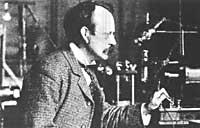J. P. Joule physical
1989/12/01 Azkune Mendia, Iñaki - Elhuyar Fundazioa Iturria: Elhuyar aldizkaria
James Prescott Joule was the son of a rich beer seller. In Salford (Lancashire), England, he first saw the light on December 24, 1818.
As a young man he got sick and spent a lot of time in his books. He studied at the University of Manchester, where he taught the prestigious chemist John Dalton.
Joule began to worry about measurement from a young age and when he turned twenty he had published works on the temperature of electric motors.
On his marriage trip he also invented a special thermometer to measure the temperatures of the upper and lower water of the waterfall they were going to see. Around 1840 he discovered the law governing the heat generated by passing the electric current on a circuit. The heat produced is the square of the intensity multiplied by the resistance.
We tried to measure the heat generated in many different processes, also measuring the work done in the generation of this heat. Through these essays, half a century earlier Rumford claimed that heat and work were related to each other. In fact, 41,800,000 erg generated heat. It is called the mechanical equivalent of heat.
Joule published his works and conclusions in 1847, but the scientists of the time did not show great enthusiasm, perhaps because Joule was not an academic (he was not a professor).
The report of his discoveries was abandoned by specialized magazines, so he had to appear at a conference in Manchester. Then, somehow, a local magazine published a lecture to him.
Months later, however, he realized his discoveries before a group of scientists, and Joule became famous among scientists, because one of his listeners, who would later be Lord Kelvin, realized his value.
Joule was not the only one who had worked to limit the mechanical equivalent of heat. Before Rumford and Mayer also worked on it, but Joule discovered the most accurate value. Therefore, the working unit is called in its honor joule (10,000,000 erg = 1 joule).
In movement, the potential energy is theoretically transformed into kinetic and vice versa, but in practice the resistance and friction of the air make the energy a little hot. However, heat is another form of energy and mechanical energy lost by air resistance and friction becomes heat. All energy is preserved. This is the law of energy conservation or the first law of Thermodynamics. Joule knew this law, but Helmholtz gave it a general formulation.
Since 1850 Joule worked alongside Thomson. In 1862 it was shown that its temperature decreases when the gas expands. This phenomenon was called Joule-Thomson and was the XIX. At the end of the 20th century it was very important to achieve low temperatures.
Joule also described the phenomenon of magnetostrication. By this phenomenon, the length of an iron bar changes slightly when magnetized.
James P. Joule, a member of the Royal Society since 1850. He was also president of the British Association for Science Development.
Joule died in Sale, near Manchester, on 11 October 1889, a hundred years ago.

Gai honi buruzko eduki gehiago
Elhuyarrek garatutako teknologia




